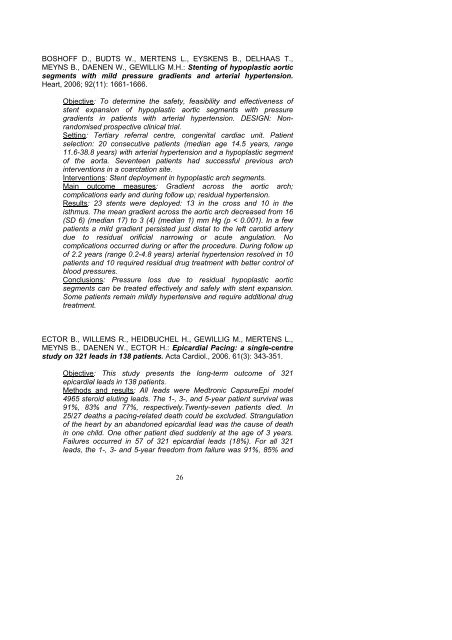2006 - UZ Leuven
2006 - UZ Leuven
2006 - UZ Leuven
Create successful ePaper yourself
Turn your PDF publications into a flip-book with our unique Google optimized e-Paper software.
BOSHOFF D., BUDTS W., MERTENS L., EYSKENS B., DELHAAS T.,MEYNS B., DAENEN W., GEWILLIG M.H.: Stenting of hypoplastic aorticsegments with mild pressure gradients and arterial hypertension.Heart, <strong>2006</strong>; 92(11): 1661-1666.Objective: To determine the safety, feasibility and effectiveness ofstent expansion of hypoplastic aortic segments with pressuregradients in patients with arterial hypertension. DESIGN: Nonrandomisedprospective clinical trial.Setting: Tertiary referral centre, congenital cardiac unit. Patientselection: 20 consecutive patients (median age 14.5 years, range11.6-38.8 years) with arterial hypertension and a hypoplastic segmentof the aorta. Seventeen patients had successful previous archinterventions in a coarctation site.Interventions: Stent deployment in hypoplastic arch segments.Main outcome measures: Gradient across the aortic arch;complications early and during follow up; residual hypertension.Results: 23 stents were deployed: 13 in the cross and 10 in theisthmus. The mean gradient across the aortic arch decreased from 16(SD 6) (median 17) to 3 (4) (median 1) mm Hg (p < 0.001). In a fewpatients a mild gradient persisted just distal to the left carotid arterydue to residual orificial narrowing or acute angulation. Nocomplications occurred during or after the procedure. During follow upof 2.2 years (range 0.2-4.8 years) arterial hypertension resolved in 10patients and 10 required residual drug treatment with better control ofblood pressures.Conclusions: Pressure loss due to residual hypoplastic aorticsegments can be treated effectively and safely with stent expansion.Some patients remain mildly hypertensive and require additional drugtreatment.ECTOR B., WILLEMS R., HEIDBUCHEL H., GEWILLIG M., MERTENS L.,MEYNS B., DAENEN W., ECTOR H.: Epicardial Pacing: a single-centrestudy on 321 leads in 138 patients. Acta Cardiol., <strong>2006</strong>. 61(3): 343-351.Objective: This study presents the long-term outcome of 321epicardial leads in 138 patients.Methods and results: All leads were Medtronic CapsureEpi model4965 steroid eluting leads. The 1-, 3-, and 5-year patient survival was91%, 83% and 77%, respectively.Twenty-seven patients died. In25/27 deaths a pacing-related death could be excluded. Strangulationof the heart by an abandoned epicardial lead was the cause of deathin one child. One other patient died suddenly at the age of 3 years.Failures occurred in 57 of 321 epicardial leads (18%). For all 321leads, the 1-, 3- and 5-year freedom from failure was 91%, 85% and26

















